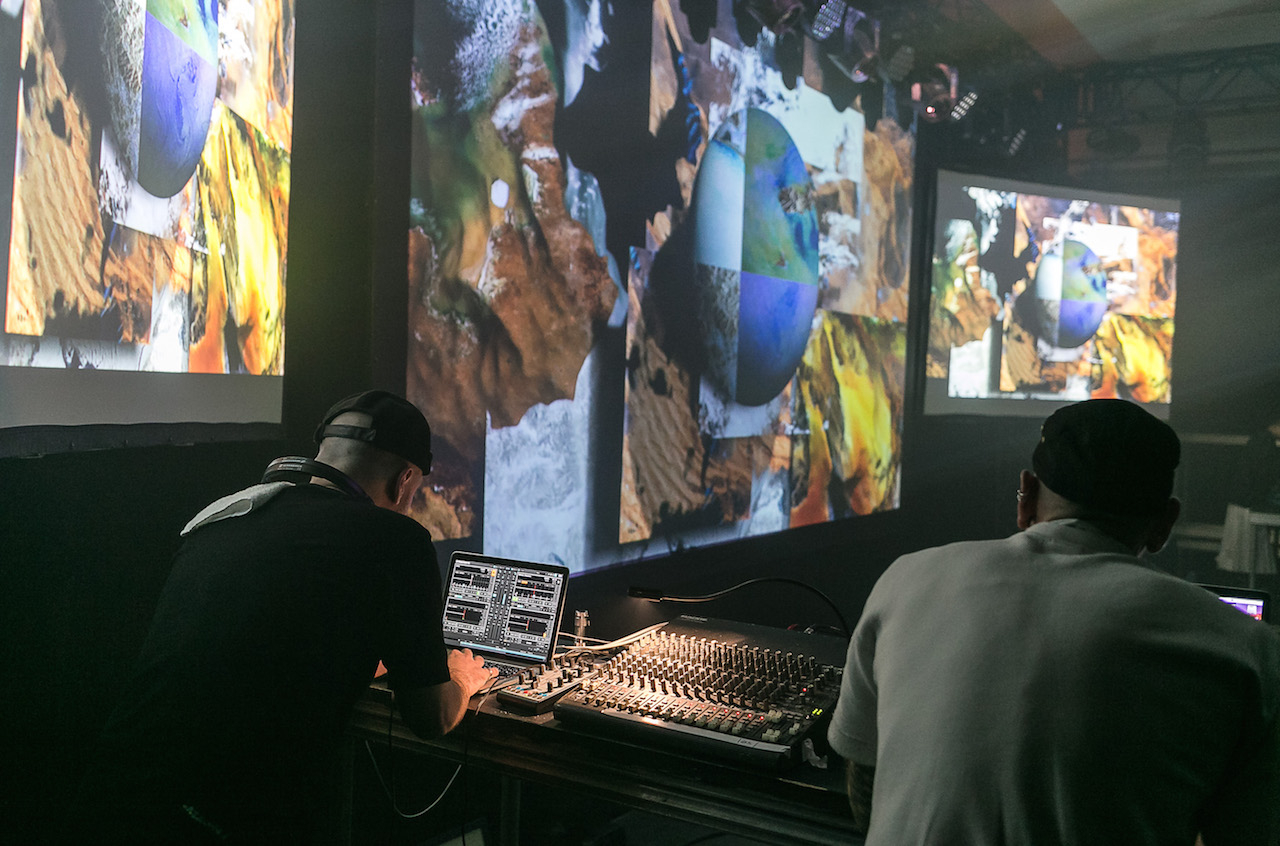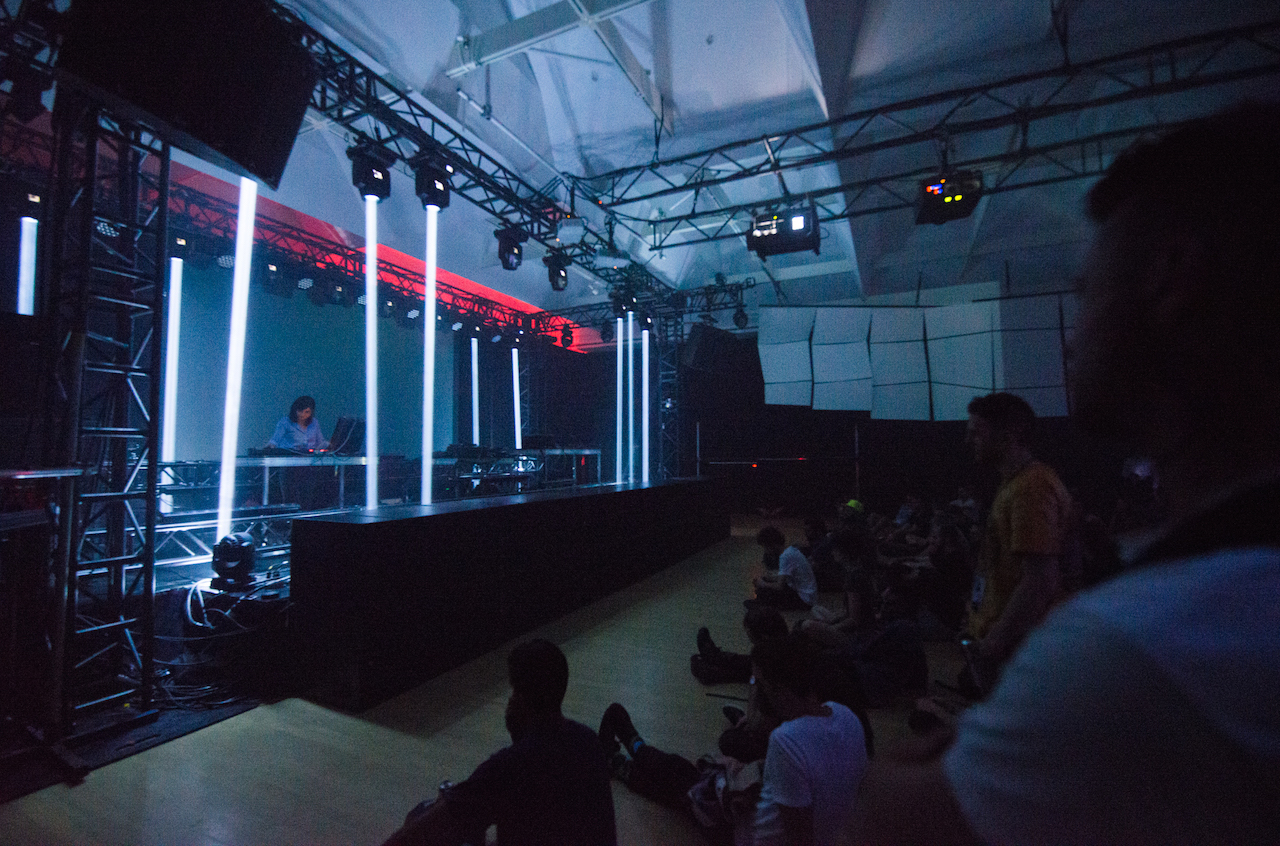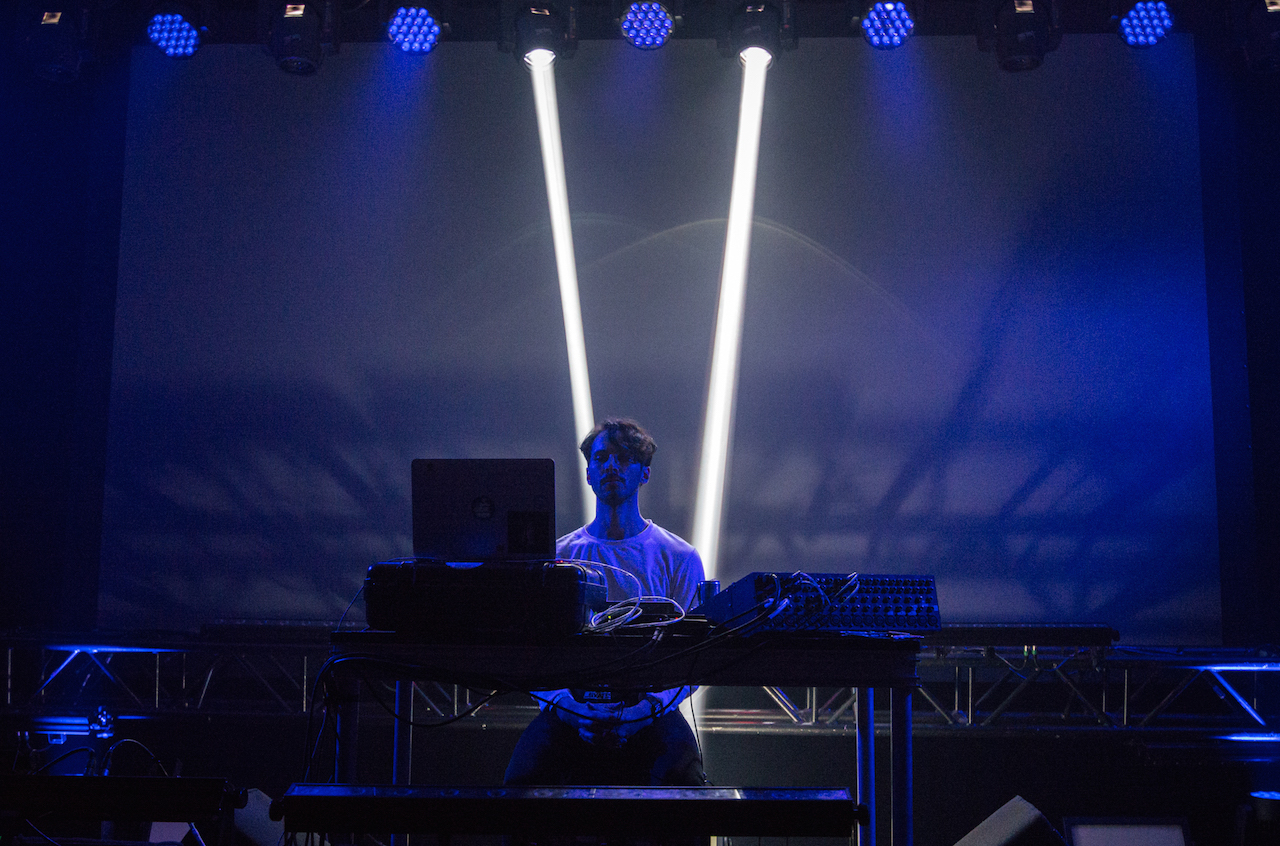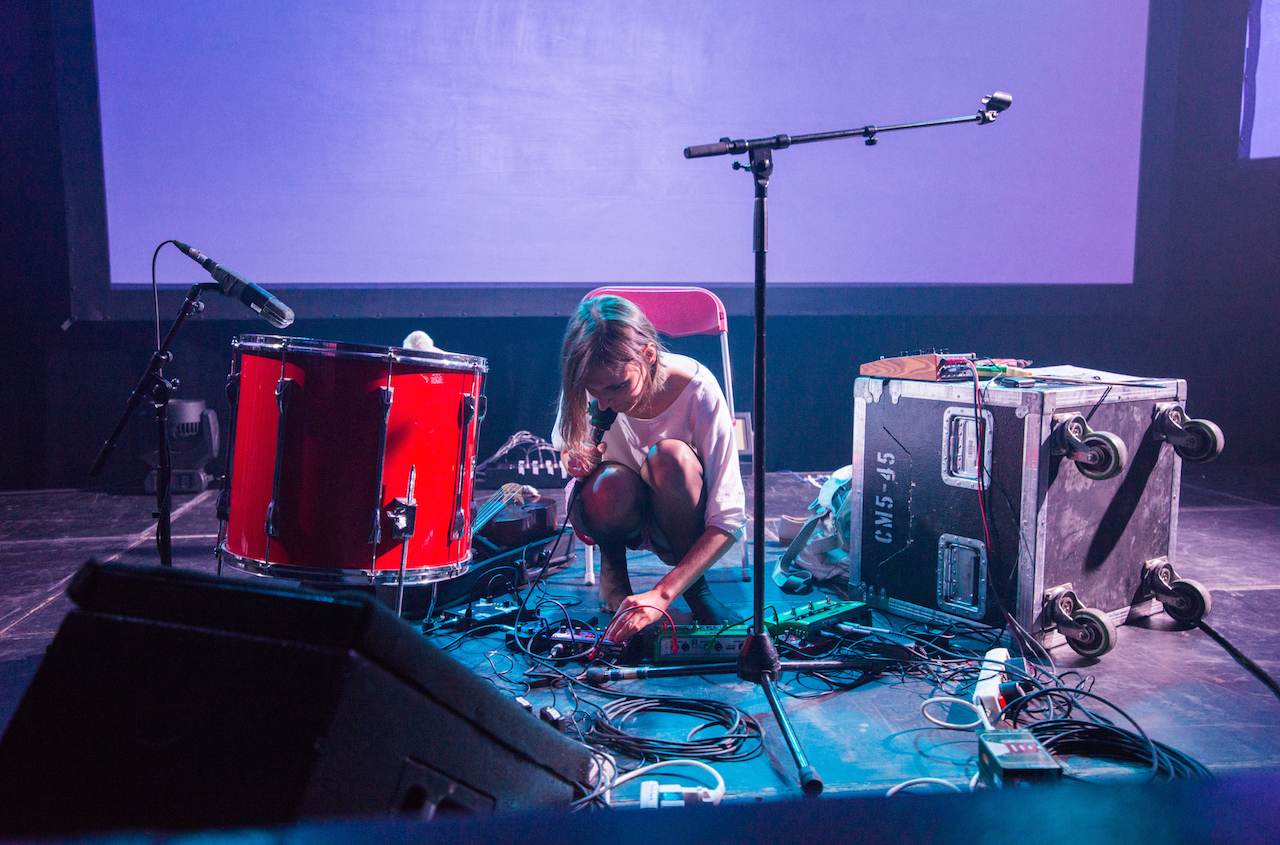Veröffentlicht
Jun 8, 2016
- MUTEK is arguably the bellwether when it comes to cutting edge and ambitiously experimental electronic music festivals. That's all the more impressive when you consider that the event, which focuses on live performance, has held that reputation for 17 years. Montreal is MUTEK's home base, and this year the festival returned to its usual haunts: the huge Metropolis nightclub, a cute little park in the Quartier Des Spectacles, a hall that housed sit-down audiovisual concerts, and, the jewel in the crown, the prestigious Musée D'Art Contemporain De Montreal. 2016's lineup was as heady as ever, but also more varied, with a focus on gender diversity—or equality, depending on who you asked—and a wide-open purview that included more straight-up dance music and even a few DJ sets, which are typically few and far between at MUTEK. The festival might have more of an academic leaning than many of its peers, but this edition proved that it's also about partying and letting loose.
Lee Gamble & Dave Gaskarth
For this performance, titled Foldings, Gamble was paired with his childhood friend and visual artist Dave Gaskarth. Like Gamble, Gaskarth's work is coloured by youthful memories of rave and dance music, which makes them natural partners. Except there wasn't much rave here. Instead, Foldings used imagery and data from the European Space Agency, along with Gaskarth's own visual wizardry, to map out imaginary landscapes in dazzling 3D renderings. The results were stunning, equal parts alien, wondrous and strangely beautiful, with a crisp clarity and blinding brightness that recalled the work of Oneohtrix Point Never-collaborator Nate Boyce. Gamble's job was to soundtrack these virtual locales, which he did with a set that ran the gamut from gaseous ambient to cerebral techno and back again. Everything he played matched what was on screen in mysterious but appropriate ways. Foldings brilliantly showcased how important multimedia—as much as music—is to the MUTEK experience.
Sarah Davachi
Sarah Davachi is a hotly-tipped name in the world of Canadian experimental music. Part of her success comes from her musicality: she approaches drone with a fetching, but never facile, sense of melody. Her performance was one of the more challenging I've seen her play, but that was mostly because it took a good while for all the layers of her composition to fall into place. A piercing, off-putting whine eventually settled into the folds of her set's constant, overwhelming sustain, while the introduction of a patient rhythm halfway through—simple, but totally memorable—was a great example of what makes her music so appealing. Though she doesn't dumb it down, this was experimental ambient music that almost anyone could enjoy. Looking around at the crowd sitting and lying on the floor of the museum, it sure seemed like everyone was having a good time.
Lorenzo Senni
I've always approached Lorenzo Senni's music with a detached sort of admiration. On paper, the way the Italian producer isolates the most overblown parts of trance and fashions them into deadly sonic weapons sounds great, but there's also something self-satisfied and knowing about the idea. It might seem like he's treating a genre of dance music as musical fodder only useful for being repurposed. But hearing Senni at MUTEK, it all made sense. His set didn't seem so much a sly wink as it did a tribute, highlighting trance's brute force by making it bluntly clear how how powerful the genre is behind all that euphoric riffing and rushing. Sirens blared, synth overtures blazed and basslines plunged, while the low-end rumble hit deep in the chest for seconds at time.
Colleen
With a whole band's worth of equipment laid out in front of her, it was hard not to be impressed by French artist Colleen in terms of her setup alone. But the way she used those instruments, from dulcet strings to drums to melodica, was more than just the sum of its parts. The misty seaside dub of her last album, Captain Of None, came alive beautifully in the Musée D'Art Contemporain, silencing the chatty crowd with its skeletal compositions in all their breathy glory. She was flanked by screens that showed her up close, lending the performance an unusually intimate feel for a festival that generally favours large-scale spectacles. She was quiet at first, but quickly opened up, nervously laughing as she told a story of how her luggage had been lost and her show nearly sabotaged. When she sang, she sounded unnervingly perfect, her voice echoing through the hall. At one point, in the middle of an older song, she stopped and started over after admitting that her performance was being filmed. I doubt anyone, transfixed as they were, noticed the mistake anyway.
Project Pablo
Patrick Holland is an adopted Montrealer with a growing fanbase in his new hometown. If you didn't know that before, you'd know it after seeing him at MUTEK, where almost every minute musical change—including the first muted keyboard chord that began the performance—elicited cheers, whoops and cries of "this one is sick!" He performed all new music, showcasing his knack for grooves that saunter between between house and disco, as well as catchy basslines with all the melodic prowess of a good pop song. His new material was similar to his work on 1080p or his new label, SOBO, with the occasional detour into harder, techno-influenced stuff. Though the transitions between songs weren't always well-executed, it hardly mattered when the songs themselves were so good. By the time he dropped "Closer," the only previously-released track in his live set, the room was all blissful smiles and leisurely dance moves. Even at one of the world's premiere experimental electronic music festivals, sometimes people just want to dance.
Photo credits /
Lead - Trung Dung Nguyen
Lee Gamble & Dave Gaskarth - Vivien Gaumand
Sarah Davachi - Trung Dung Nguyen
Lorenzo Senni - Trung Dung Nguyen
Colleen - Trung Dung Nguyen
Project Pablo - Vivien Gaumand
 Sarah Davachi Sarah Davachi is a hotly-tipped name in the world of Canadian experimental music. Part of her success comes from her musicality: she approaches drone with a fetching, but never facile, sense of melody. Her performance was one of the more challenging I've seen her play, but that was mostly because it took a good while for all the layers of her composition to fall into place. A piercing, off-putting whine eventually settled into the folds of her set's constant, overwhelming sustain, while the introduction of a patient rhythm halfway through—simple, but totally memorable—was a great example of what makes her music so appealing. Though she doesn't dumb it down, this was experimental ambient music that almost anyone could enjoy. Looking around at the crowd sitting and lying on the floor of the museum, it sure seemed like everyone was having a good time.
Sarah Davachi Sarah Davachi is a hotly-tipped name in the world of Canadian experimental music. Part of her success comes from her musicality: she approaches drone with a fetching, but never facile, sense of melody. Her performance was one of the more challenging I've seen her play, but that was mostly because it took a good while for all the layers of her composition to fall into place. A piercing, off-putting whine eventually settled into the folds of her set's constant, overwhelming sustain, while the introduction of a patient rhythm halfway through—simple, but totally memorable—was a great example of what makes her music so appealing. Though she doesn't dumb it down, this was experimental ambient music that almost anyone could enjoy. Looking around at the crowd sitting and lying on the floor of the museum, it sure seemed like everyone was having a good time. Lorenzo Senni I've always approached Lorenzo Senni's music with a detached sort of admiration. On paper, the way the Italian producer isolates the most overblown parts of trance and fashions them into deadly sonic weapons sounds great, but there's also something self-satisfied and knowing about the idea. It might seem like he's treating a genre of dance music as musical fodder only useful for being repurposed. But hearing Senni at MUTEK, it all made sense. His set didn't seem so much a sly wink as it did a tribute, highlighting trance's brute force by making it bluntly clear how how powerful the genre is behind all that euphoric riffing and rushing. Sirens blared, synth overtures blazed and basslines plunged, while the low-end rumble hit deep in the chest for seconds at time.
Lorenzo Senni I've always approached Lorenzo Senni's music with a detached sort of admiration. On paper, the way the Italian producer isolates the most overblown parts of trance and fashions them into deadly sonic weapons sounds great, but there's also something self-satisfied and knowing about the idea. It might seem like he's treating a genre of dance music as musical fodder only useful for being repurposed. But hearing Senni at MUTEK, it all made sense. His set didn't seem so much a sly wink as it did a tribute, highlighting trance's brute force by making it bluntly clear how how powerful the genre is behind all that euphoric riffing and rushing. Sirens blared, synth overtures blazed and basslines plunged, while the low-end rumble hit deep in the chest for seconds at time. Colleen With a whole band's worth of equipment laid out in front of her, it was hard not to be impressed by French artist Colleen in terms of her setup alone. But the way she used those instruments, from dulcet strings to drums to melodica, was more than just the sum of its parts. The misty seaside dub of her last album, Captain Of None, came alive beautifully in the Musée D'Art Contemporain, silencing the chatty crowd with its skeletal compositions in all their breathy glory. She was flanked by screens that showed her up close, lending the performance an unusually intimate feel for a festival that generally favours large-scale spectacles. She was quiet at first, but quickly opened up, nervously laughing as she told a story of how her luggage had been lost and her show nearly sabotaged. When she sang, she sounded unnervingly perfect, her voice echoing through the hall. At one point, in the middle of an older song, she stopped and started over after admitting that her performance was being filmed. I doubt anyone, transfixed as they were, noticed the mistake anyway.
Colleen With a whole band's worth of equipment laid out in front of her, it was hard not to be impressed by French artist Colleen in terms of her setup alone. But the way she used those instruments, from dulcet strings to drums to melodica, was more than just the sum of its parts. The misty seaside dub of her last album, Captain Of None, came alive beautifully in the Musée D'Art Contemporain, silencing the chatty crowd with its skeletal compositions in all their breathy glory. She was flanked by screens that showed her up close, lending the performance an unusually intimate feel for a festival that generally favours large-scale spectacles. She was quiet at first, but quickly opened up, nervously laughing as she told a story of how her luggage had been lost and her show nearly sabotaged. When she sang, she sounded unnervingly perfect, her voice echoing through the hall. At one point, in the middle of an older song, she stopped and started over after admitting that her performance was being filmed. I doubt anyone, transfixed as they were, noticed the mistake anyway. Project Pablo Patrick Holland is an adopted Montrealer with a growing fanbase in his new hometown. If you didn't know that before, you'd know it after seeing him at MUTEK, where almost every minute musical change—including the first muted keyboard chord that began the performance—elicited cheers, whoops and cries of "this one is sick!" He performed all new music, showcasing his knack for grooves that saunter between between house and disco, as well as catchy basslines with all the melodic prowess of a good pop song. His new material was similar to his work on 1080p or his new label, SOBO, with the occasional detour into harder, techno-influenced stuff. Though the transitions between songs weren't always well-executed, it hardly mattered when the songs themselves were so good. By the time he dropped "Closer," the only previously-released track in his live set, the room was all blissful smiles and leisurely dance moves. Even at one of the world's premiere experimental electronic music festivals, sometimes people just want to dance. Photo credits / Lead - Trung Dung Nguyen Lee Gamble & Dave Gaskarth - Vivien Gaumand Sarah Davachi - Trung Dung Nguyen Lorenzo Senni - Trung Dung Nguyen Colleen - Trung Dung Nguyen Project Pablo - Vivien Gaumand
Project Pablo Patrick Holland is an adopted Montrealer with a growing fanbase in his new hometown. If you didn't know that before, you'd know it after seeing him at MUTEK, where almost every minute musical change—including the first muted keyboard chord that began the performance—elicited cheers, whoops and cries of "this one is sick!" He performed all new music, showcasing his knack for grooves that saunter between between house and disco, as well as catchy basslines with all the melodic prowess of a good pop song. His new material was similar to his work on 1080p or his new label, SOBO, with the occasional detour into harder, techno-influenced stuff. Though the transitions between songs weren't always well-executed, it hardly mattered when the songs themselves were so good. By the time he dropped "Closer," the only previously-released track in his live set, the room was all blissful smiles and leisurely dance moves. Even at one of the world's premiere experimental electronic music festivals, sometimes people just want to dance. Photo credits / Lead - Trung Dung Nguyen Lee Gamble & Dave Gaskarth - Vivien Gaumand Sarah Davachi - Trung Dung Nguyen Lorenzo Senni - Trung Dung Nguyen Colleen - Trung Dung Nguyen Project Pablo - Vivien Gaumand